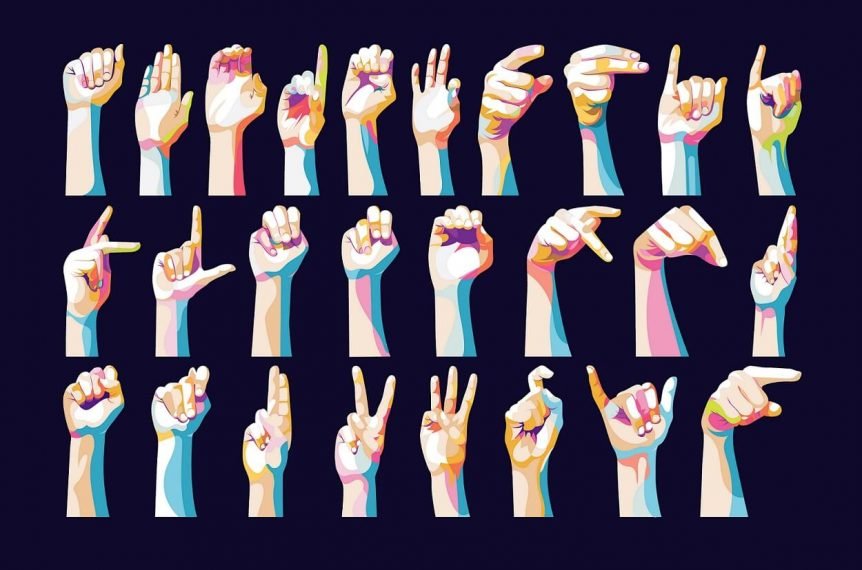Understanding Sign Language: A Beginner’s Guide

sign language
Sign language is a visual language used by the Deaf and hard-of-hearing communities to communicate. It relies on hand signs, facial expressions, and body language to convey meaning. Unlike spoken languages, which use vocal cords and sounds, sign languages use gestures and visual cues. This makes sign language an essential tool for many people, allowing them to express themselves and interact with others.
Learning sign language can be incredibly beneficial. It opens up new ways of communication, enhances inclusivity, and fosters better understanding between those who are Deaf or hard-of-hearing and those who are not. Additionally, knowing sign language can improve cognitive skills and deepen empathy. For many, it also represents a way to connect with a vibrant and rich culture.
History and Evolution of Sign Language
Origins and Early Development
The origins of sign language date back to ancient times. Early forms of signing were used in various cultures, including the Greeks and Romans, to communicate with those who were Deaf. However, modern sign language as we know it began to take shape in the 18th century. French educator Abbé Charles-Michel de l’Épée is credited with developing the first structured system of sign language in France, which laid the foundation for other sign languages around the world.
Key Milestones and Modern Adaptations
Over time, sign languages have evolved and adapted to the needs of their users. In the 19th century, American Sign Language (ASL) was developed from French Sign Language, influencing many other sign languages globally. Advances in technology and media have also played a role in spreading and standardizing sign languages. Today, sign language continues to evolve, incorporating new signs and adapting to cultural changes.
Different Types of Sign Languages
American Sign Language (ASL)
American Sign Language (ASL) is one of the most widely used sign languages in the United States and Canada. It has its own grammar and vocabulary, distinct from English. ASL is a complete language with its own syntax and structure, which means it does not simply translate words from English into signs. It has evolved over time and incorporates elements from various languages and cultures.
British Sign Language (BSL)
British Sign Language (BSL) is used primarily in the United Kingdom. It is different from ASL and has its own unique signs and grammatical rules. BSL is influenced by the history and culture of the Deaf community in Britain. Despite some similarities, BSL and ASL are distinct languages with their own syntax and vocabulary.
Other Regional Variations
In addition to ASL and BSL, there are many other regional sign languages. For example, Australian Sign Language (Auslan) and New Zealand Sign Language (NZSL) each have their own unique characteristics. These variations often reflect the cultural and historical influences of their regions. Learning about different sign languages can provide insights into the diverse ways people communicate around the world.
Basic Sign Language Vocabulary
Common Greetings and Phrases
When starting to learn sign language, it’s useful to begin with common greetings and phrases. For example, the sign for “hello” involves raising your hand to your forehead and then moving it away. “Thank you” is signed by placing your fingers on your chin and moving your hand outward. These basic signs are essential for everyday interactions and help build foundational skills in sign language.
Essential Everyday Signs
In addition to greetings, it’s important to learn signs for everyday needs. For instance, the sign for “food” involves placing your dominant hand near your mouth and making a motion as if eating. “Help” is signed by placing your dominant hand under your non-dominant hand and moving it upward. Mastering these signs can greatly enhance your ability to communicate in daily situations.
How to Learn Sign Language
Recommended Resources and Tools
To learn sign language effectively, it’s important to use a variety of resources. Online courses, apps, and video tutorials can provide valuable instruction and practice. Books and dictionaries specifically about sign language can also be useful for expanding your vocabulary and understanding grammar. Joining local sign language classes or community groups can offer hands-on practice and real-life interaction.
Tips for Practice and Improvement
Practice is key to becoming proficient in sign language. Regularly practicing with a partner or in a group setting can help reinforce learning. Watching sign language videos and mimicking the signs can also improve your skills. Additionally, immersing yourself in Deaf culture and attending Deaf events can enhance your understanding and fluency.
The Role of Sign Language in Society
How Sign Language Facilitates Communication
Sign language plays a crucial role in facilitating communication for the Deaf and hard-of-hearing communities. It enables them to participate fully in conversations, education, and various aspects of daily life. By providing a means of communication that is accessible and inclusive, sign language helps bridge gaps between different communities and fosters better understanding.
Sign Language in Education and Workplaces
In educational settings, sign language ensures that Deaf students have equal access to learning opportunities. Schools and universities often provide interpreters or offer sign language courses to support Deaf students. In the workplace, knowing sign language can improve job prospects and enhance communication with colleagues and clients. This inclusivity helps create a more equitable environment for everyone.
Challenges and Misconceptions
Common Misunderstandings About Sign Language
Despite its importance, there are many misconceptions about sign language. One common misunderstanding is that sign language is universal; in reality, there are many different sign languages. Another myth is that sign language is merely a signed version of spoken language, but it is a complete language with its own grammar and vocabulary.
Overcoming Obstacles in Learning and Usage
Learning sign language can present challenges, such as finding quality resources or practicing with fluent users. However, these obstacles can be overcome with persistence and the right support. Engaging with the Deaf community, seeking out educational resources, and practicing regularly can help you overcome these challenges and achieve fluency.
Conclusion
Sign language is a vital tool for communication, fostering inclusivity and understanding between Deaf and hearing individuals. Its rich history, diverse types, and practical applications make it an important skill to learn. Whether for personal enrichment or professional development, learning sign language opens up new opportunities and helps build a more connected world.







